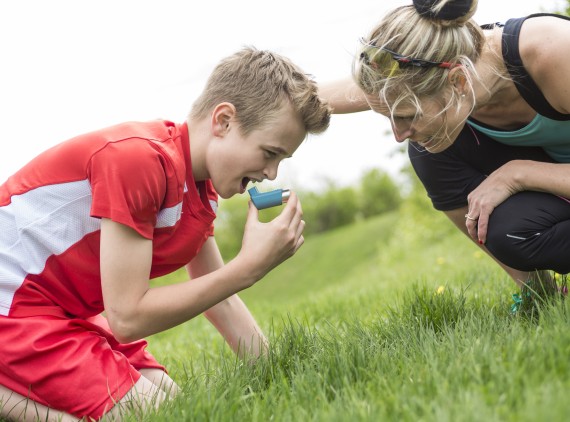Regular exercise is an essential part of a healthy lifestyle, but in patients with poorly controlled asthma, exercise is a common trigger for asthma symptoms. In some patients, the symptoms are manifested only during exercise, thus called exercise-induced asthma or maybe better termed as exercise-induced bronchospasm (EIB). EIB symptoms start 5-10 min after stopping intense activity but can happen during exercise as well. Typical symptoms are coughing, wheezing, and chest tightness. If untreated, it may take up to 30-90 minutes to recover. Exposure to specific triggers, e.g., cold air, pollen, etc. during exercise can exacerbate the asthma symptoms.
Asthma symptoms during exercise can be controlled so that a person can be as active as his peers. A person can achieve this control by using a bronchodilator for 15-30 min before exercise as well as identifying and avoiding the triggers. Bronchodilators are the inhalers that help open airways, thus preventing any bronchospasm during exercise. Avoiding triggers like pollen by not exercising outside when the outdoor pollen count is high is also helpful. Using a scarf over the nose and mouth helps if cold air is causing asthma symptoms. Warming up before exercise is also a valuable tip to prevent exercise-induced symptoms.
Sometimes exercise-induced symptoms can be confusing as there may be other causes in addition to EIB. It may be an entirely different cause. Often pediatricians attribute all exercise symptoms to EIB.
But in otherwise healthy children, EIB is present only in small fraction of patients complaining of shortness of breath with activity. The misdiagnosis in many patients causes partial or no improvement with medications leading to frustration.
There could be many other causes of shortness of breath during activity, including deconditioning (relative unfitness), vocal cord dysfunction, obesity, cardiac causes, etc. Vocal cord dysfunction is a disorder where vocal cords close instead of opening when you breathe in causing symptoms of throat closing and shortness of breath during exercise. Cardiopulmonary exercise testing is a specialized type of stress test that measures your exercise ability and collects information about your lung and heart. It can diagnose many of these causes. This test is done on a treadmill or bike.
The Exercise Stress Lab at Phoenix Children’s Hospital performs cardiopulmonary exercise testing in children not routinely available at other centers. Cardiologist, Arash Sabati, MD, and pulmonologist, Rajeev Bhatia, MD, collaborate to run this lab. Finding the cause of exercise limitation, which may or may not be asthma, can be very helpful for patients in determining a specific intervention. For example, vocal cord dysfunction needs the learning of breathing techniques to help with symptoms.
Other than treating exercise-induced asthma and its imitators, Phoenix Children’s Pulmonology Division has a state-of-the-art asthma program, including a Severe Asthma Clinic and the Breathmobile. The Severe Asthma Clinic has both allergists and pulmonologists who work together to manage difficult-to-treat asthma. Phoenix Children’s Breathmobile is a self-contained mobile asthma clinic that travels to Phoenix-area schools and community sites. The unit provides asthma identification, teaching, treatment, and follow-up care to uninsured children and children who have limited or no access to care. This is a one-of-a-kind program in the state of Arizona.

